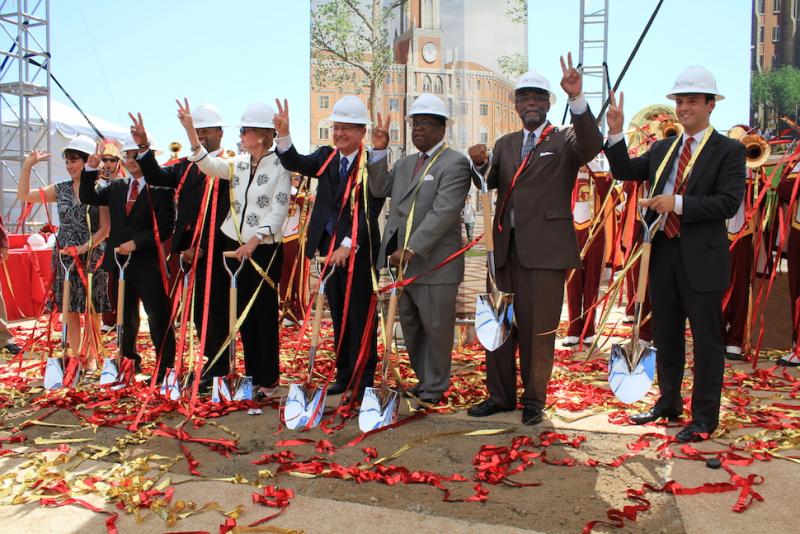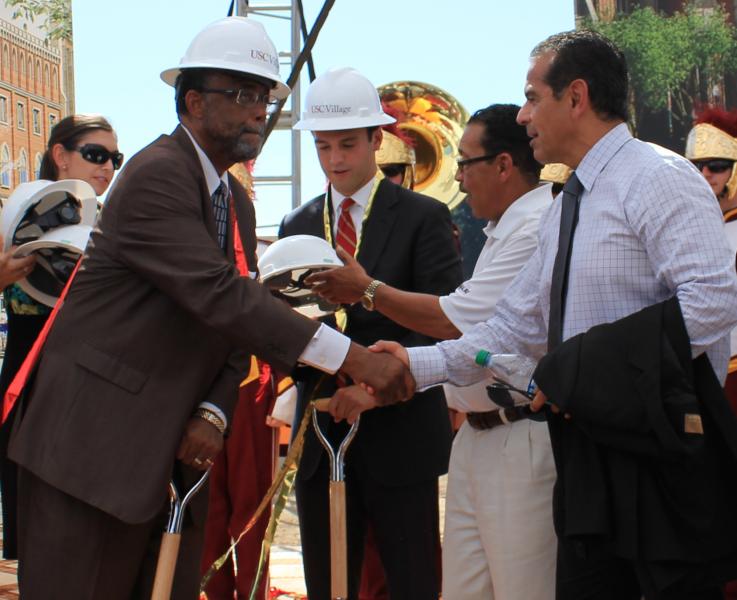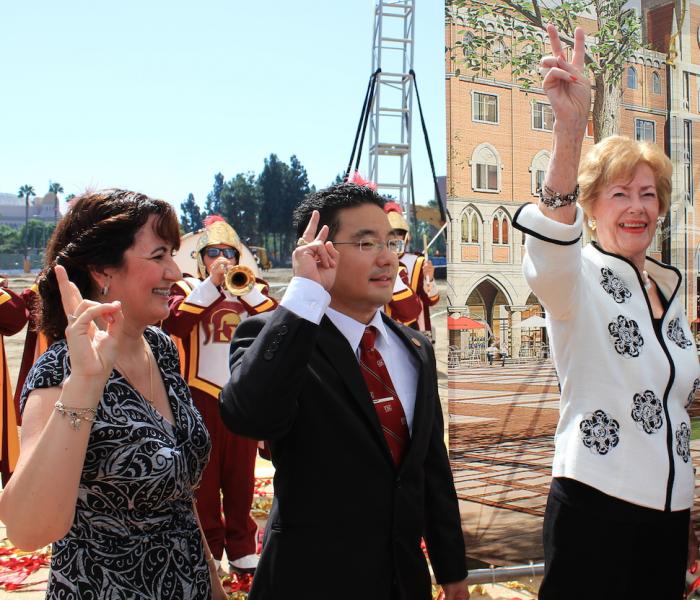
Community members, student leaders, trustees and local politicians break ground with USC president Max Nikias. | Phoenix Tso/Neon Tommy
Nearly 950 members of the USC community gathered Monday morning in 90-degree weather to celebrate the groundbreaking of the new USC Village, a project that aims to raise USC’s reputation around the world.
“There will be no one to catch up to,” said USC president C.L. Max Nikias about the appeal of specific project features to incoming students. These features include the 2700 beds to be added by 2017, and the retail space that will open up and about the McCarthy Honors College, which Trustee Kathleen Leavey McCarthy donated $30 million to build for incoming merit scholarship students. “Everyone will want to go where the action is.”
In the days leading up to the groundbreaking, admissions officials were excitedly anticipating how to market these features to next year’s freshmen. During the ceremony, President Nikias spoke of how USC was committed to transforming from a commuter university to a residential one, like “other preeminent universities.”
“This is special for us,” said Timothy Brunold, USC Dean of Admissions, in a phone interview in the days leading up to the groundbreaking. “The students we’re currently recruiting will be able to use it.”

President Nikias addresses the crowd at the USC Village groundbreaking ceremony. | Phoenix Tso/Neon Tommy
The Village will also allow USC to offer students neighborhood features on par with similar California universities like Stanford and UCLA. Dean Brunold said that Admissions doesn’t pay much attention to rankings like that of U.S. News and World Report, which last week ranked UCLA two spots higher than USC. However, he hoped that the Village could establish a college town feel that other competitors already have.
For Evelyn Wallace, a high school junior from the San Francisco suburbs who took an admissions tour at USC last Friday, adjusting to a bigger city like L.A. is a concern.
“The USC Village helps my decision, because there will be more retail stores and other places accessible from campus,” she said.
As an undergraduate at another L.A. area university, Graduate Student Council president Yohey Tokumitsu frequented former University Village businesses like Denny’s after USC football games.
“I’m not only excited for the students, but for the community,” he said. “There will be all this retail space for them. Also, everyone [will want] to be like us. Features like the Honors College are motivating [for prospective students].”
Administration members hope that USC Village itself will evoke other elite universities in other aspects.
“This has the look of Oxford,” said Craig Keys, to an audience of around 20 community members at a USC village civic engagement meeting last Wednesday, when showing the final design to them. “This gives us 1000 years of history that we don’t have.” At the groundbreaking ceremony, President Nikias repeated this line to audience laughter.

L.A. District 9 councilman Curren Price greets former mayor Antonio Villaraigosa after the groundbreaking. | Phoenix Tso/Neon Tommy
Community members were also excited about what the design evokes. “The final design on the flyer that we received for this meeting is more interesting than the ones before,” said Reuben McDowell Jr., who has lived by USC on Ellendale Place since 1984, and who attended the civic engagement meeting. “It’s like St. Mark’s Square in Venice.”
However, McDowell also questioned what the chosen design said about USC’s priorities. “USC wants to identify with the top of the echelon in terms of [university] design. But they didn’t use any of the L.A. architectural look,” he said. “UCLA has a mix of traditional and modern, but [USC is] looking back 800 years.”
USC and its surrounding community do seem to be looking forward, at least in terms of promised community benefits. This includes a promise to employ 30 percent of its construction workers from the local area. “So far there have only been around 10 people on the site doing demolition, so we’ll have to see when the project goes vertical [around February],” said Ernest Roberts, Executive Director of PV Jobs, the non-profit that works with project contractors and local unions to fill this recruitment goal.
Roberts, who is a USC alumnus, and who started PV Jobs in order to give the at-risk community employment opportunities, also said that this promise represents a pivotal moment for the university: “They talk a lot about social engagement, but this is really where the rubber hits the road. They can really demonstrate to the at-risk community that they care.”
This article was originally published on Neon Tommy. Reach Neon Tommy Staff Reporter Phoenix Tso here and follow her on Twitter here.
















Speak Your Mind